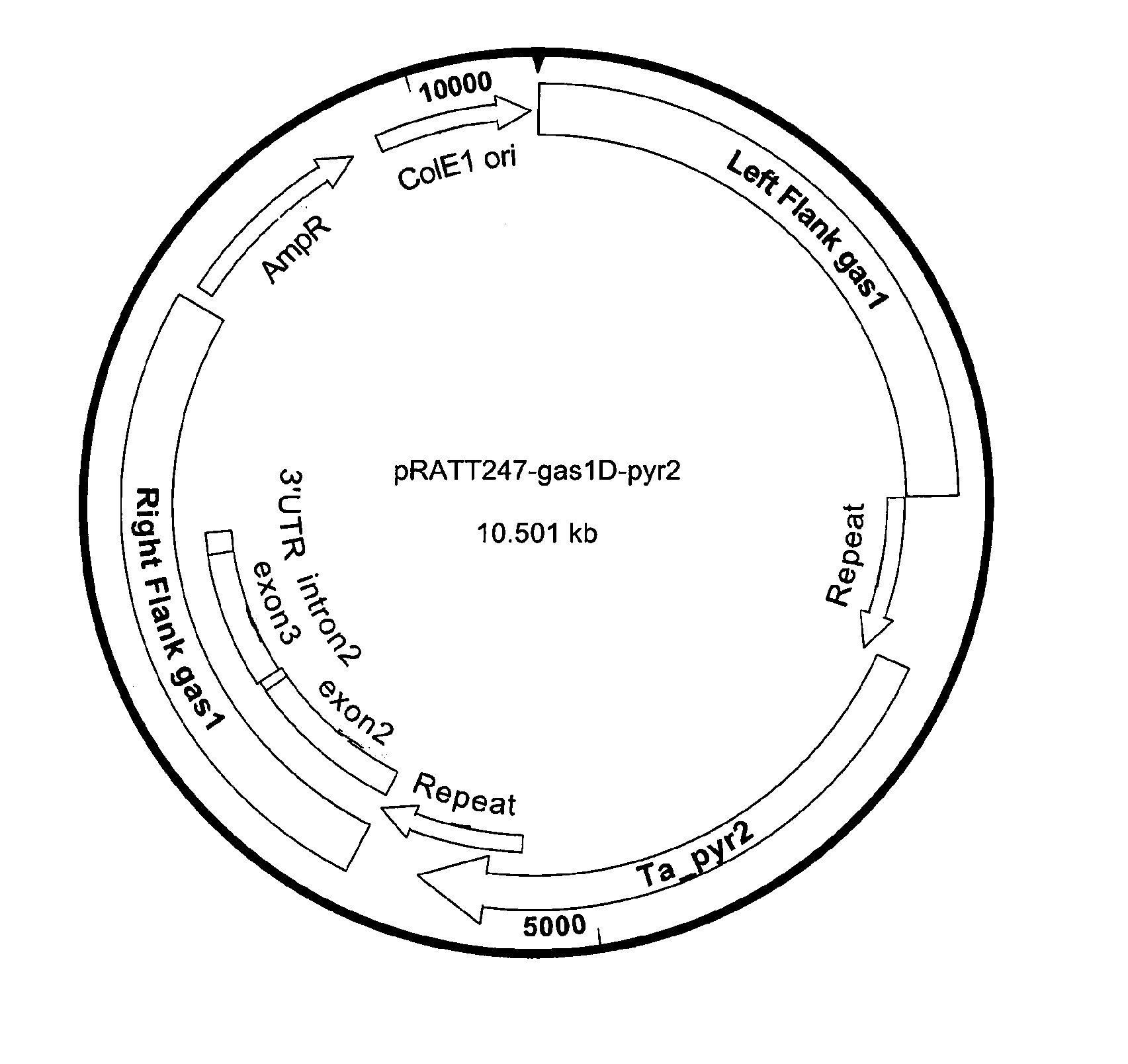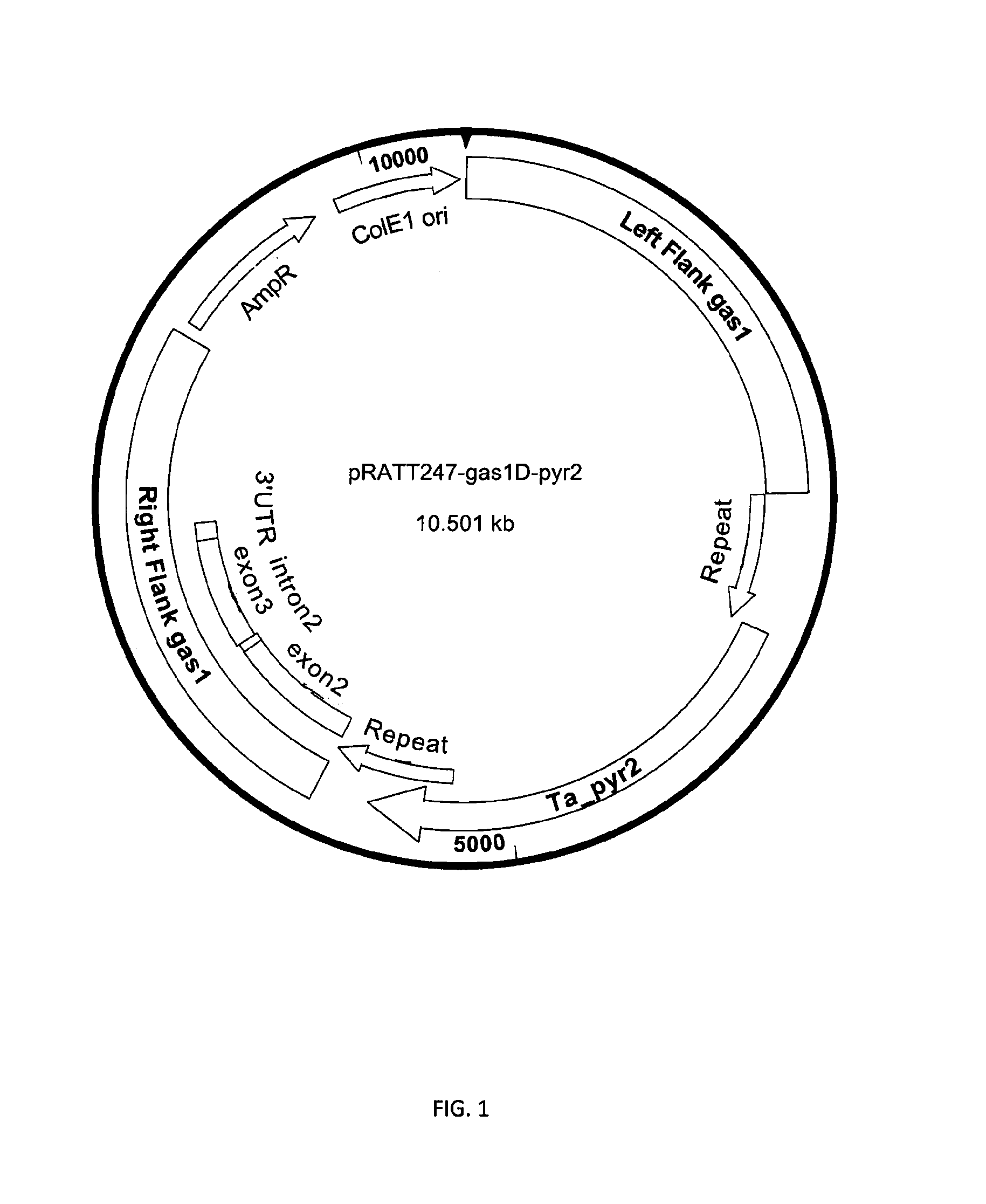Filamentous fungi having an altered viscosity phenotype
a filamentous fungus and viscosity technology, applied in the field of gene mutations in filamentous fungi, can solve the problems of less uniform distribution of oxygen and nutrients, affecting bioreactor performance, and more energy required for agitation of culture, and achieve the effect of increasing the dissolved oxygen conten
- Summary
- Abstract
- Description
- Claims
- Application Information
AI Technical Summary
Benefits of technology
Problems solved by technology
Method used
Image
Examples
example 1
Deletion of the gas1 Gene from T. reesei Mutant Morph 77B7
[0178]A Trichoderma reesei Morph strain was deleted for four major cellulase genes, including cbhI, cbhII, egII, and egIV, which makes it particular suitable for expressing other proteins in the absence of or in reduced cellulase background. See, WO 05 / 001036.
A. TrGA Producing Strain Morph 77B7
[0179]The Morph strain, described above, was previously transformed with a native Trichoderma glucoamylase gene (TrGA) under control of the CBH1 promoter, using amdS as a marker. A transformant containing two tandem copies of glucoamylase (TrGA 29-9) was subsequently isolated, and random chemical mutagenesis was used to produce a mutant (77B7). A spontaneous pyr2 mutant derivative was subsequently isolated by 5-fluoro-orotic acid (FOA) selection.
B. Generation of a gas1 Disruption Cassette
[0180]The Trichoderma reesei gas1 (PID 22914) was deleted from mutant Morph 77B7. The gas1 disruption cassette plasmid pRATT247 (FIG. 1) was prepared u...
example 2
Additive Effect Produced by Altering at Least One of Sfb3, Seb1, Mpg1, Crz1, and Tps2 Production
[0191]A. Viscosity Reduction in Disrupted sbf3
[0192]The Sfb3 gene (also known as Lst1) has previously only been characterized in budding yeast (i.e., Saccharomyces cerevisiae), where it encodes a protein associated with the COPII protein coat surrounding transport vesicles that carry proteins from the endoplasmic reticulum to the Golgi apparatus. Sfb3, as well as Sfb2, are homologs of Sec24, all of which genes are involved with packaging specific cargo proteins into the vesicles.
[0193]As shown in Table 3, disrupting the sfb3 gene from strain 29-9 Δsfb3 resulted in a strain having a reduction in the highest agitation rate required to maintain the dissolved oxygen at 40% at the end of the growth phase. Under these growth conditions, the original strain, 29-9, required 2.6 times more power than either the 70H2 (chemically mutagenized 29-9) or 29-9 Δsfb3 strains in order to maintain a DO of 4...
PUM
| Property | Measurement | Unit |
|---|---|---|
| concentration | aaaaa | aaaaa |
| concentration | aaaaa | aaaaa |
| concentration | aaaaa | aaaaa |
Abstract
Description
Claims
Application Information
 Login to View More
Login to View More - R&D
- Intellectual Property
- Life Sciences
- Materials
- Tech Scout
- Unparalleled Data Quality
- Higher Quality Content
- 60% Fewer Hallucinations
Browse by: Latest US Patents, China's latest patents, Technical Efficacy Thesaurus, Application Domain, Technology Topic, Popular Technical Reports.
© 2025 PatSnap. All rights reserved.Legal|Privacy policy|Modern Slavery Act Transparency Statement|Sitemap|About US| Contact US: help@patsnap.com


